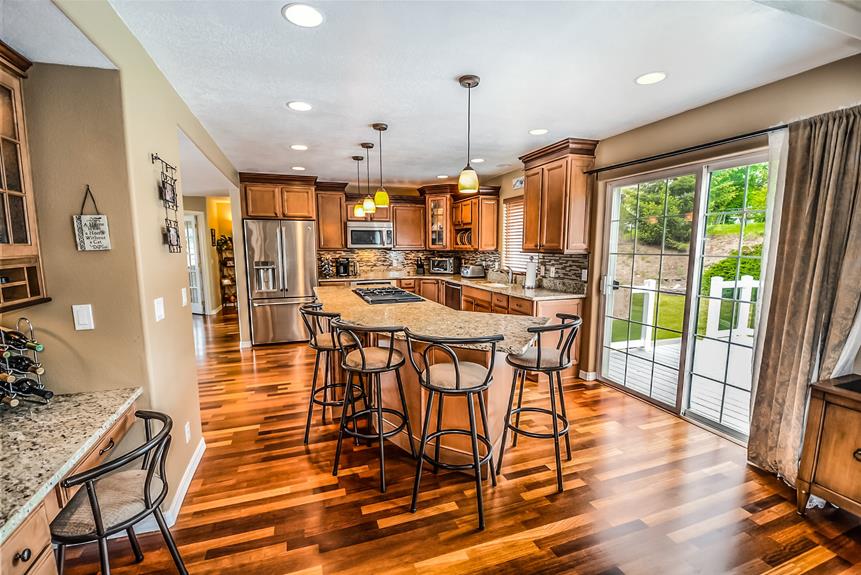The process of selecting kitchen appliances is a critical aspect of designing an ideal kitchen space. These appliances not only contribute to the overall style of the kitchen but also significantly enhance its functionality. Therefore, making the right choice requires careful consideration.
With an overwhelming array of options available in the market, it is important to evaluate factors such as style, functionality, reliability, and technology. Efficiency and performance should be prioritized when purchasing appliances, while the size and layout of the kitchen must also be taken into account.
Additionally, ample storage space for organizing kitchen utensils and tools is crucial. By thoroughly assessing these factors, individuals can make informed decisions and choose the ideal kitchen appliances that perfectly match their needs and preferences, resulting in a visually appealing and highly functional kitchen space.
Key Takeaways
- Consider features like style, functionality, reliability, and technology when choosing kitchen appliances.
- Efficiency and performance are key factors to consider when purchasing appliances.
- The appearance of the appliances in the kitchen is important.
- Take into account the size, layout, flow, and traffic patterns in the kitchen when selecting appliances.
Importance of Kitchen Appliances
The significance of kitchen appliances cannot be overstated. Kitchen appliances play a vital role in the functionality and efficiency of a kitchen. They are essential for various cooking and food preparation tasks, making our lives easier and saving us valuable time.
From refrigerators and ovens to dishwashers and microwaves, these appliances contribute to the smooth running of a modern kitchen. They not only enhance the cooking experience but also add to the overall aesthetics of the space.
Choosing the right appliances is crucial, considering factors such as style, functionality, reliability, and technology. With the wide range of options available, it is important to make informed decisions that meet your specific needs and preferences.
Investing in high-quality appliances ensures durability and long-term satisfaction in the kitchen.
Factors to Consider When Choosing Appliances
When considering factors to consider when choosing appliances for your kitchen, it is important to evaluate the efficiency and performance of the options available. Efficiency refers to the energy consumption and running costs of the appliances, while performance refers to how well they perform their intended functions.
Look for appliances with high energy efficiency ratings and features that contribute to their overall performance.
Another important factor to consider is the size and layout of your kitchen. Ensure that the appliances you choose fit well within the available space and allow for easy movement and access. Additionally, consider the flow and traffic patterns in your kitchen to ensure a smooth and efficient cooking experience.
Lastly, think about the storage space available for organizing your kitchen utensils and tools, as well as any specific features or technologies you may desire in your appliances.
Efficiency and Performance
To ensure optimal functionality and energy savings, it is essential to prioritize efficiency and performance when selecting kitchen appliances. Here are three key considerations to keep in mind:
- Energy Efficiency: Look for appliances with high Energy Star ratings, as they consume less energy and help reduce utility bills. Energy-efficient appliances also have a lower environmental impact.
- Performance: Consider the power and performance capabilities of the appliances. Look for features like fast heating elements in stovetops, powerful motors in blenders, and quick-cooling refrigerators. Pay attention to customer reviews to gauge the performance of the appliances.
- Durability: Invest in appliances that are built to last. Look for models made with high-quality materials and backed by reliable warranties. Durability ensures that your appliances will continue to perform optimally for years to come, saving you money on repairs or replacements.
Appearance in the Kitchen
Aesthetics play a crucial role in selecting kitchen appliances, as they contribute to the overall style and ambiance of the kitchen space. The appearance of the appliances in the kitchen is an important factor to consider when choosing them.
The design and finish of the appliances should complement the overall decor and theme of the kitchen. Stainless steel appliances are popular for their modern and sleek look, while retro-inspired appliances can add a vintage charm.
Additionally, consider the color scheme and texture of the appliances, ensuring they blend well with the surrounding cabinets and countertops. By carefully selecting kitchen appliances that are visually appealing, you can create a cohesive and visually pleasing kitchen design.
Size and Layout of the Kitchen
Consider the dimensions and arrangement of your kitchen when selecting the ideal appliances. The size and layout of your kitchen play a crucial role in determining the appliances that will fit seamlessly into your space.
Here are three key considerations to keep in mind:
- Space availability: Measure the available space in your kitchen to ensure that the appliances you choose will fit properly. Consider the height, width, and depth of each appliance to avoid any issues with installation or functionality.
- Traffic flow: Take into account the flow of movement in your kitchen. Consider how the appliances will impact the ease of movement and accessibility in the space. Ensure that there is enough room for multiple people to work in the kitchen without feeling cramped or obstructed.
- Work triangle: The work triangle refers to the distance between the refrigerator, sink, and stove, which are the three main work areas in the kitchen. Optimize the layout of your appliances to create an efficient work triangle that minimizes unnecessary steps and facilitates a smooth cooking process.
Flow and Traffic Patterns
The consideration of flow and traffic patterns is essential in optimizing the functionality and efficiency of the kitchen space. When designing the layout of the kitchen, it is important to create a smooth flow between different work areas, such as the cooking, cleaning, and food preparation areas. This allows for easy movement and minimizes any potential bottlenecks or congestion.
Additionally, considering traffic patterns is crucial in ensuring that the kitchen is accessible and safe for everyone using it. It is important to plan for clear pathways and ample space to move around, especially in areas where multiple people may be working simultaneously.
Storage Space for Utensils and Tools
To effectively optimize the functionality and organization of the kitchen, it is imperative to allocate ample storage space for utensils and tools. This ensures that everything has its designated place, making it easier to find and access items when needed.
Here are three key considerations when it comes to storage space for utensils and tools:
- Drawer Dividers: Installing drawer dividers allows for efficient organization of utensils such as spoons, forks, and knives. It prevents them from getting tangled or misplaced, making it easier to find what you need during meal preparation.
- Wall-Mounted Racks: Utilizing wall-mounted racks maximizes vertical space in the kitchen. These racks can hold various tools such as pans, pots, and ladles, keeping them easily accessible while freeing up valuable counter or cabinet space.
- Magnetic Strips: Magnetic strips mounted on the wall provide a convenient storage solution for knives, scissors, and other metal tools. This keeps them within reach while also reducing the risk of accidents from sharp objects being scattered in drawers.
Ensuring Safety and Efficiency in Utensils
When optimizing the functionality and organization of the kitchen, it is imperative to prioritize safety and efficiency in utensils. Choosing the right utensils can greatly enhance the cooking experience and ensure that food preparation is done with ease and precision. To help you make informed decisions, here are some key factors to consider when selecting utensils:
| Factor | Importance |
|---|---|
| Specialized utensils | Using utensils specifically designed for chopping, slicing, and mincing ingredients can improve safety and efficiency. |
| Proper size | Utensils that are appropriately sized for the task at hand can make cooking more efficient and prevent accidents. |
| Nonstick cookware | Opting for utensils with nonstick surfaces, such as those made with Teflon, can make cooking and cleaning easier. |
| O-ring Teflon | Utensils with O-ring Teflon provide excellent moisture resistance, ensuring longevity and preventing rust or damage. |
| Ergonomic design | Utensils with ergonomic handles can provide a comfortable grip, reducing strain and enhancing safety during use. |
Frequently Asked Questions
What Are Some Common Maintenance Tips for Kitchen Appliances?
Some common maintenance tips for kitchen appliances include cleaning regularly, checking for any signs of wear and tear, ensuring proper ventilation, and following the manufacturer's instructions for maintenance and repairs. Regular maintenance helps extend the lifespan and efficiency of the appliances.
How Can I Determine the Energy Efficiency of a Kitchen Appliance?
When determining the energy efficiency of a kitchen appliance, consider its energy star rating, annual energy consumption, and energy-saving features. Look for appliances with high efficiency ratings and features like programmable settings and smart technology.
What Are Some Considerations for Choosing the Right Finish for Kitchen Appliances?
Considerations for choosing the right finish for kitchen appliances include matching the overall kitchen aesthetic, durability, ease of cleaning, and resistance to fingerprints and smudges. It is also important to consider the longevity of the finish and its ability to withstand daily use.
Are There Any Specific Safety Features I Should Look for in Kitchen Appliances?
Ensuring safety in kitchen appliances is paramount. Look for features like automatic shut-off, child lock, and safety sensors. Efficiency can be enhanced with energy-saving options, such as programmable timers and smart technology.
What Are Some Innovative Technologies Available in Modern Kitchen Appliances?
Innovative technologies in modern kitchen appliances include smart features like voice control and Wi-Fi connectivity, advanced cooking techniques like induction and steam ovens, and energy-efficient options such as solar-powered appliances. These technologies enhance convenience, efficiency, and sustainability in the kitchen.
Conclusion
In conclusion, selecting the ideal kitchen appliances requires careful consideration of various factors such as efficiency, performance, appearance, size, layout, flow, traffic patterns, and storage space.
By evaluating these factors, individuals can make an informed decision that enhances both the style and functionality of their kitchen.
While the vast array of options available in the market can be overwhelming, taking the time to assess these factors will ultimately result in a kitchen space that is aesthetically pleasing and highly functional.




